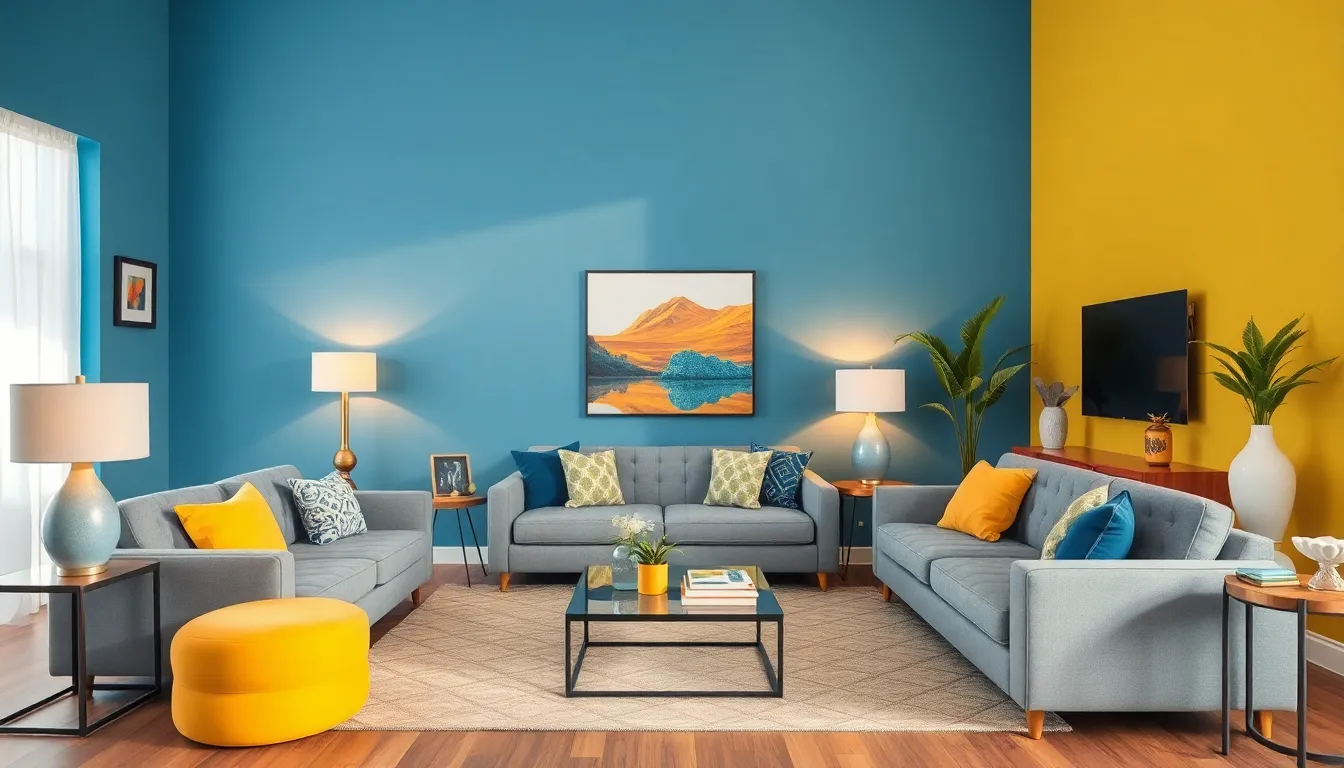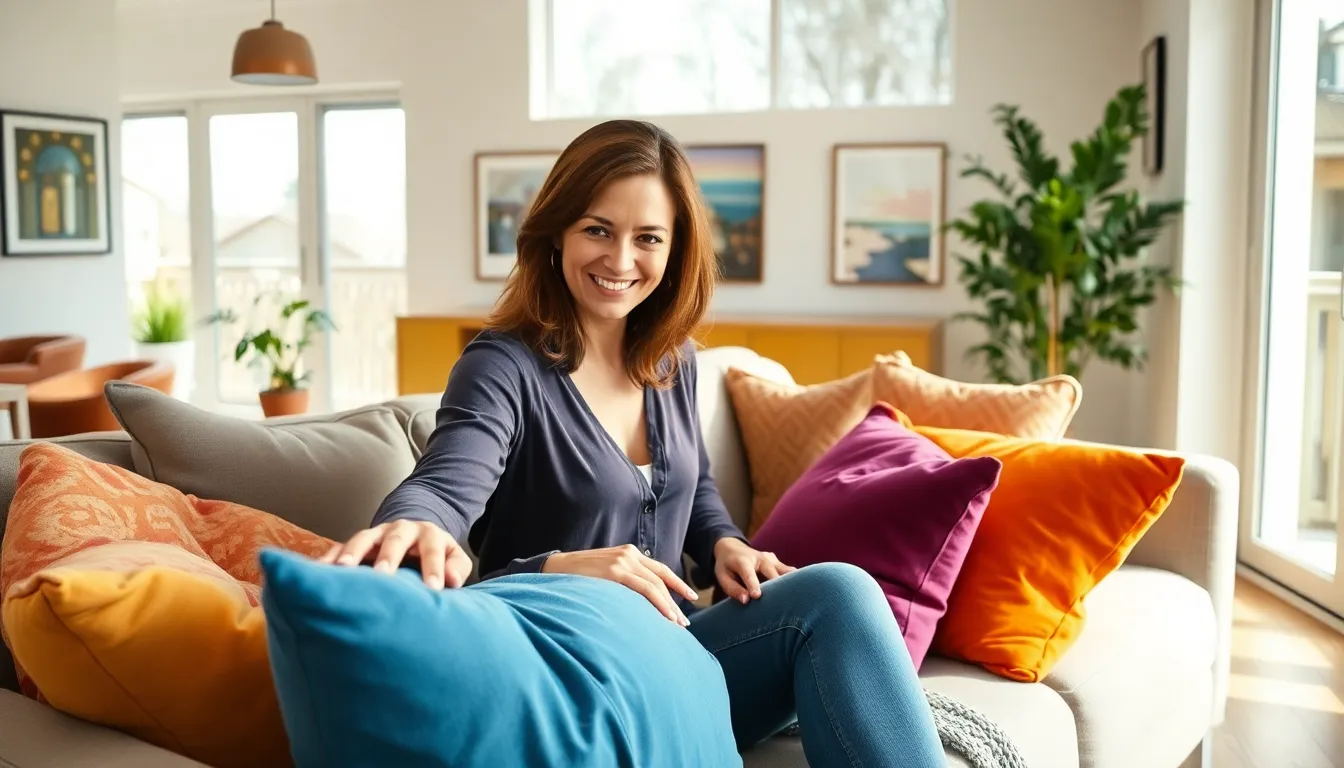Transforming a space isn’t just about slapping on a fresh coat of paint and rearranging the furniture. It’s an art form that combines creativity, functionality, and a dash of magic to make a home truly shine. Interior planning goes beyond aesthetics; it’s about crafting an environment that reflects personality while enhancing everyday life.
Imagine walking into a room that feels like a warm hug, where every piece of furniture whispers sweet nothings and every color tells a story. With the right interior planning, that dream can become a reality. Whether you’re a design novice or a seasoned pro, understanding the principles of interior planning can elevate a space from drab to fab faster than you can say “open concept.” Get ready to dive into a world where style meets strategy, and every inch of your home becomes a masterpiece waiting to happen.
Table of Contents
ToggleWhat Is Interior Planning?
Interior planning involves a strategic approach to designing and organizing spaces. It encompasses aspects such as space allocation, color selection, and furniture arrangement. Effective interior planning focuses on maximizing functionality and aesthetic appeal while reflecting the user’s style.
Designers begin by assessing a space’s existing dimensions and layout. After evaluating these elements, they create a plan that aligns with the needs and preferences of those using the space. Combining creativity with practical considerations enables the transformation of ordinary rooms into cohesive environments.
Several key principles guide the process of interior planning. First, functionality remains a priority, ensuring that the space serves its intended purpose. Next, aesthetics play a crucial role, as a visually pleasing design enhances enjoyment and comfort. Moreover, sustainability increasingly influences design choices, with many opting for eco-friendly materials and energy-efficient solutions.
Color schemes significantly impact the mood and perception of a room. Designers often choose colors that complement each other and create a harmonious environment. Lighting also plays a vital role; well-planned lighting highlights design elements and creates ambiance.
Furthermore, spatial flow affects how individuals move through an area. Thoughtful furniture placement allows for easy navigation while promoting conversation and interaction. Designers also incorporate personal touches through artwork and decor, making the space feel unique and inviting.
Interior planning aims to harmonize elements for a functional and inviting environment. By understanding the various components, anyone can appreciate how meticulous planning elevates a space from ordinary to extraordinary.
Key Elements of Interior Planning

Interior planning encompasses several essential components that contribute to transforming a space effectively.
Space Layout
Space layout involves arranging furniture and features to optimize flow and functionality. Designers assess dimensions to create areas that promote ease of movement. Using zoning techniques, they define distinct regions for various activities, such as relaxing, working, or entertaining. Open concepts encourage integration, while defined rooms offer privacy. Creating balance through strategic placement of furniture enhances visual appeal. Assigning dedicated spaces for each function allows for a comfortable environment. Effective layout planning aligns closely with user preferences.
Color Schemes
Color schemes play a crucial role in influencing mood and ambiance. Selecting a harmonious palette enhances the overall aesthetic of a space. Designers consider color psychology to evoke specific emotions; for example, blue promotes tranquility while yellow adds warmth. Utilizing accent walls can create focal points and contrast. Natural light impacts color perception, making it vital to assess how colors appear in different lighting. Consistency in chosen colors throughout a space ensures cohesion and unity. Incorporating textiles and artwork can add depth and interest to the overall color scheme.
Furniture Selection
Furniture selection significantly affects both style and functionality. Choosing pieces that complement the overall design enhances a room’s character. Designers prioritize durability, comfort, and aesthetics when selecting items. Measuring available space ensures that furniture fits proportionally and doesn’t overcrowd the area. Versatile pieces, such as adaptable couches or nesting tables, optimize usability in small spaces. Prioritizing quality over quantity leads to a more cohesive and functional environment. Styles should align with personal taste while addressing practical needs for everyday living.
Benefits of Effective Interior Planning
Enhancing spaces through effective interior planning offers numerous advantages. Improved functionality ranks high among them, as thoughtful layouts create efficient environments that cater to daily activities. Budget-friendly solutions emerge when strategic planning reduces unnecessary expenses on renovations or furnishings.
Aesthetic appeal significantly increases with proper planning. Designers skillfully select colors, textures, and patterns that harmonize, fostering a pleasant atmosphere. Personalization occurs naturally when individual tastes are incorporated into designs, making spaces reflect unique styles.
Environmental sustainability gains importance as eco-friendly materials feature prominently in planning. Raising awareness about sustainable options supports eco-conscious living while maintaining style. Overall well-being is bolstered since thoughtfully designed spaces positively influence mood, promoting relaxation and productivity.
Increased property value is another benefit of meticulous interior planning. Attractive, functional spaces appeal to potential buyers or renters, yielding better market positioning. Safety considerations cannot be overlooked; spaces designed with safety in mind minimize risks and enhance overall comfort for occupants.
Time savings emerge from effective space allocation, as strategic designs allow for seamless navigation. Clarity in layout reduces confusion, benefiting guests and residents alike. Spatial flow fosters social interaction, creating inviting environments for gatherings.
Creativity flourishes within well-planned spaces, inspiring individuals to express themselves through decor and design choices. Flexibility in design allows for adaptability over time, accommodating changing needs or tastes effortlessly. Ultimately, effective interior planning transforms environments, enriching lives through both beauty and practicality.
Common Challenges in Interior Planning
Interior planning presents various challenges that demand careful consideration. Budget constraints often emerge as a primary concern for many homeowners and designers alike.
Budget Constraints
Effective interior planning often hinges on a well-defined budget. Designers work within financial limitations to prioritize essential elements. Selecting high-quality materials can elevate a space, yet affordability remains crucial. Compromises may occur, leading to choices between aesthetics and functionality. Interior planners frequently seek cost-effective solutions that align with clients’ visions while staying within monetary boundaries. Considering these financial factors is essential for creating fulfilling yet viable designs.
Space Limitations
Space limitations challenge interior planners to maximize every square foot. Designers assess dimensions to create functional layouts that cater to user needs. In smaller areas, innovative storage solutions help maintain organization without sacrificing style. Each element must serve a purpose to avoid overcrowding. Open concepts can enhance flow in compact spaces, fostering a sense of openness. Successful planning in limited environments often relies on strategic zoning techniques, ensuring functionality and comfort remain priorities.
Trends in Interior Planning
Current trends in interior planning emphasize sustainability, minimalism, and multifunctionality. Homeowners increasingly seek eco-friendly materials, such as reclaimed wood and low-VOC paints. Designers now prioritize energy-efficient solutions, like LED lighting and smart home technologies. This shift towards sustainable practices enhances both environmental impact and aesthetic value.
Minimalist design remains popular, focusing on clean lines and uncluttered spaces. Neutral color palettes, including whites, beiges, and greys, dominate current trends. These colors create a calming atmosphere while allowing for personal accents through decor. Accessories such as textured throws and unique artwork add character without overwhelming simplicity.
Multifunctional furniture is gaining traction as living spaces become more compact. Versatile pieces, such as sofa-beds and extendable dining tables, provide adaptability for various activities. This approach maximizes utility within limited square footage, catering to urban living demands.
Furthermore, open floor plans continue to shape interior layouts. These designs promote fluidity and connectivity, making spaces feel larger and more inviting. Zoning techniques help define areas within these layouts, creating distinct functional zones. Designers frequently use area rugs and spatial dividers to enhance flow and organization.
Finally, biophilic design is emerging as a vital aspect of modern interiors. Incorporating natural elements, such as plants and water features, fosters a connection with nature. This trend promotes well-being by improving air quality and creating serene environments. Overall, interior planning trends reflect a desire for spaces that combine functionality, aesthetics, and sustainability.
Effective interior planning is essential for creating spaces that are both functional and aesthetically pleasing. By prioritizing personal style and practicality, individuals can transform their environments into welcoming havens.
Embracing current trends such as sustainability and multifunctionality ensures that spaces not only meet today’s demands but also enhance overall well-being.
With thoughtful planning and a clear vision, anyone can elevate their home or workspace, making it a true reflection of their personality while maximizing comfort and efficiency.

